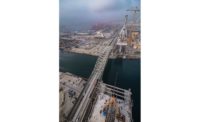...retired.” Also, some of the project’s major pieces, such as components of the pivoting gates, had been exposed to the elements for years.
“We needed to revise design codes, incorporating increased motorway design loadings affecting our bridge and viaduct,” says Edwards. Yet design upgrades had to remain in accordance with the existing built structures. “Our gate profile was amended for new codes and new loads, but had to fit in the existing docking chamber,” he says. Bridge and tunnel joints also had to be updated. For example, “For tunnel waterproofing we are now using PVC instead of welded steel, and coating cylinder piston rods with metallic oxide rather than chrome,” he says.
At first, the construction cost estimate was about $400 million. But the government asked for an increased scope of work, including expansion of the highway from four to six lanes, increased channel dredging to a depth of 16 m rather than 12 m, and design for a 100-year life. These factors, plus inflation, all bumped up the construction cost estimate to $3 billion, says Panchuk. “It is difficult to calculate the loss due to the 30-year delay,” he adds.
The current work includes more than 75 contractors and 30 subcontractors, with the local Directorate for the Flood Protection Barrier of Rosstroy serving as general manager. Crews had to retrieve abandoned segments fabricated in the 1980s and repair them, says Ivan Borisovich Seryogin, project manager for Atomstroyexport, the Russian contractor completing construction of the gate system, as well as mechanical work on the sluice gates. The contractor also fabricated 10 new segments for the 23-m-high pivoting-gate system, which at rest sits 2 m above typical water level.
The pivoting-gate assembly guards a 200-m-wide channel, designated as S1. Each gate half is shaped like a 5,000-tonne steel pie slice, with two 4.5-m-thick steel pontoons forming the “crusts” and tapering into 122-m-long arms composed of steel elements assembled and bolted together. When in the open position, the two gate halves rest in curved dry docks. In a severe weather event, the docks will be flooded to allow the gates to float out into the shut position with the aid of electric tractors, meeting at an angle in the middle of the 200-m-wide channel. The process will take about 45 minutes. Work started in July 2007, and construction is just about complete, says Seryogin. Mechanical testing will take up most of next year, he adds.
The highway running atop the floodwall system will dip into a 26-m-deep tunnel beneath the channel. Dutch firm Boskalis dredged the construction pit on the tunnel’s south end, about 14 ft below the water surface, in 2007. “They dug out several million cubic meters of gulf and built two benches on either side,” says Alexey Kislenko, Halcrow technical manager. Germany’s Hochtief AG is leading completion of the 2-km-long pair of tunnels, supported on 900 bored piles and consisting of cast-in-place reinforced-concrete box sections, backfilled with sand. Each tunnel is 15.25 m wide and 10 m high.
The barrier system also includes six sets of 200-m-wide discharge sluice gates and a more conventional vertical-lift gate that will seal the second channel, known as S2, which is about 150 m wide. The steel-beam 2,500-tonne gate, similar to those designed to protect Venice, rests in a chamber at the bottom of the channel. Hydraulic cylinders will raise it as needed up to 22 m. A 120-m-long steel-box girder bridge spans the channel and can be raised or lowered 9 m by a pulley system, but in normal conditions allows for a 16 m clearance. When construction resumed, crews found 200 segments of the gate sitting in a casting yard. The bridge had been built but was not connected to the rest of the highway, recalls Edwards.
The steel sluice gates required repairs and mechanical equipment upgrading. Their purpose is to control balance of water flows between the bay and the gulf, says Panchuk. Each of the six sluices have 10 or 12 steel radial gates, each 24 m wide and up to 8 m in height, says Edwards. Two sets were incomplete when construction resumed. The original design to protect the city from a 1,000-year flood was double-checked for a 10,000-year flood, or a 5.15-m rise in water level. Concrete infill will help break up ice in the winter, a problem encountered after the construction of the first two gates.
Crews are wrapping up construction of a central control room on a nearby island that will allow an operator to control all the sluice gates at once. Engineers hope to use the sluices to not only balance water flow but for environmental purposes. “We’re considering closing one side of the barrier and opening the other to create artificial currents to clean up the water” in case of oil spills or other accidents, says Panchuk.



Post a comment to this article
Report Abusive Comment